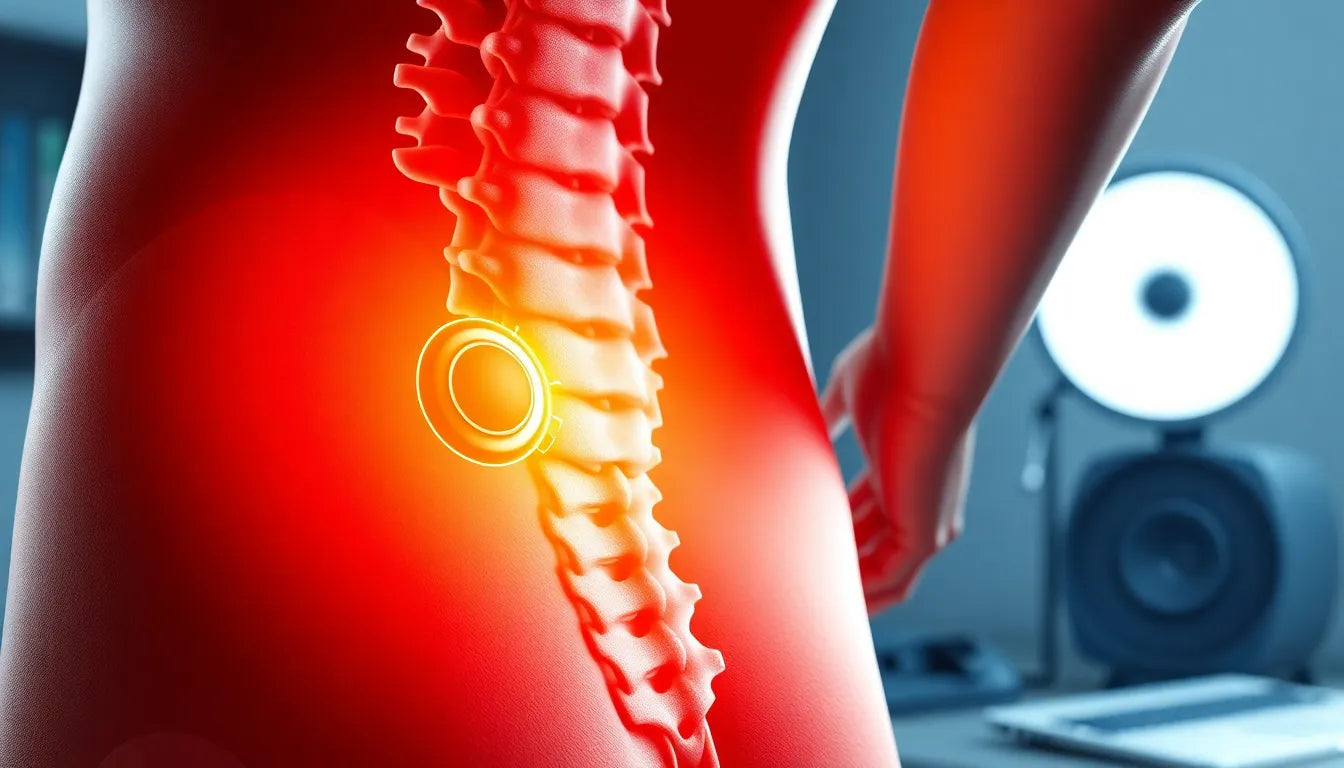A herniated disc in the upper back, medically referred to as a thoracic herniated disc, is a condition that can significantly impact one's quality of life. This condition occurs when the soft, gel-like center of a spinal disc pushes through a crack in the tougher exterior casing, potentially causing pain and discomfort. Although herniated discs are more common in the lower back, they can occur in the thoracic spine, the section of the spine located in the upper and middle back. Addressing this condition promptly is crucial, as it can affect daily activities and overall mobility.
Recognizing common symptoms
Individuals with a herniated disc in the upper back often experience a range of symptoms that can vary in intensity. One of the most prevalent symptoms is sharp, axial pain localized in the upper back. This pain can be persistent and may worsen with certain movements or activities. Additionally, sufferers might experience numbness and weakness in the affected area, which can extend to the chest or abdomen. Some people report electric-like sensations that radiate from these regions, adding to the discomfort and complicating movement.
The importance of early diagnosis
Early diagnosis of a thoracic herniated disc is vital for effective management and to prevent further complications. Identifying the condition in its initial stages allows for a broader range of treatment options, potentially avoiding the need for more invasive procedures. Consulting with healthcare professionals is essential for an accurate diagnosis and to develop a personalized treatment plan. These professionals can use imaging tests and physical examinations to determine the severity of the herniation and recommend appropriate interventions.
Addressing a herniated disc in the upper back promptly can lead to better outcomes and a quicker return to normal activities. By understanding the symptoms and seeking early medical advice, individuals can take proactive steps to manage their condition and improve their quality of life.
Exploring causes and risk factors of a herniated disc in the upper back
A herniated disc in the upper back can arise from various causes and is influenced by several risk factors. Common causes include physical injury, which can result from sudden trauma or repetitive strain on the thoracic spine. Poor posture, especially prevalent in individuals who spend long hours sitting or standing incorrectly, can also contribute to the development of this condition. Additionally, degenerative disc disease, a natural part of the aging process where discs lose hydration and elasticity, can lead to herniation.
Risk factors for developing a thoracic herniated disc encompass age, as the likelihood increases with advancing years. Lifestyle choices, such as a sedentary routine or engaging in activities that place excessive strain on the back, further elevate the risk. Genetic predisposition also plays a role, suggesting that individuals with a family history of disc problems may be more susceptible.
Non-surgical treatment options for thoracic herniated discs
For many patients, non-surgical treatments can effectively manage symptoms and improve quality of life. One of the primary approaches is rest and activity modification. Allowing time for rest can significantly reduce inflammation and alleviate pain. However, it's crucial to balance rest with gentle movement; complete immobility can lead to muscle weakness and stiffness. Modifying daily activities to avoid movements that exacerbate pain is also recommended.
Physical therapy is another cornerstone of non-surgical treatment, offering benefits such as strengthening back muscles and enhancing flexibility. A physical therapist might recommend exercises like gentle stretches, core strengthening routines, and posture correction techniques tailored to the individual's condition. These exercises not only relieve current symptoms but also help prevent future occurrences.
Pain management is an integral part of the treatment plan. Over-the-counter medications, such as non-steroidal anti-inflammatory drugs (NSAIDs), can help reduce pain and swelling. In some cases, muscle relaxants may be prescribed to alleviate muscle spasms. Alternative therapies, including acupuncture and chiropractic care, have also shown promise in providing relief for some patients. These therapies focus on holistic approaches to pain management and can be complementary to conventional treatments.
When surgery becomes necessary
While non-surgical treatments are effective for many, there are situations where surgical intervention may be necessary. Surgery is typically considered when conservative treatments fail to alleviate severe pain or when neurological deficits, such as significant weakness or loss of sensation, are present. In such cases, surgical options like discectomy, where the herniated portion of the disc is removed, or spinal fusion, which stabilizes the spine, may be recommended.
It's important for patients to discuss the potential risks and benefits of surgery with their healthcare provider to make an informed decision. Surgery often offers relief from symptoms and improves function, but it is usually seen as a last resort after exploring all other options.
Understanding the causes, risk factors, and treatment options for a herniated disc in the upper back is crucial for effective management. By addressing the condition with a comprehensive approach that includes both non-surgical and, if necessary, surgical interventions, patients can find relief and regain their quality of life.
Preventive strategies for managing a herniated disc in the upper back
Preventing a herniated disc in the upper back involves adopting strategies that focus on maintaining spinal health and minimizing risk factors. One of the most effective prevention methods is practicing proper body mechanics. This includes maintaining good posture throughout daily activities, whether sitting, standing, or lifting objects. Ergonomic practices, such as adjusting your workstation to ensure your monitor is at eye level and your chair supports your lower back, can significantly reduce strain on the thoracic spine.
Additionally, when lifting heavy objects, it is crucial to use correct techniques to avoid placing undue stress on your back. Bend at the knees and keep the object close to your body while lifting with your legs rather than your back. These simple adjustments can help prevent injury and maintain spinal health.
Incorporating lifestyle changes for spinal health
Beyond body mechanics, lifestyle modifications play a crucial role in preventing herniated discs. Regular exercise is vital, as it helps maintain a healthy weight and strengthens the muscles that support the spine. Incorporating exercises that focus on core strength and flexibility can provide additional support to the thoracic region and reduce the risk of disc herniation.
A balanced diet rich in nutrients that support bone health, such as calcium and vitamin D, is also beneficial. Maintaining a healthy weight reduces the load on the spine, decreasing the likelihood of disc problems. Furthermore, quitting smoking is essential, as smoking can impair blood flow to the spinal discs, accelerating degeneration. Managing stress through techniques like yoga or meditation can also contribute to overall well-being and spinal health.
Conclusion
Understanding and addressing a herniated disc in the upper back is essential for maintaining quality of life. By recognizing symptoms early and seeking professional medical advice, individuals can explore a range of treatment options tailored to their needs. While non-surgical treatments are often effective, surgery may be necessary in severe cases. Implementing preventive strategies, such as proper body mechanics and lifestyle changes, can significantly reduce the risk of developing this condition. Ultimately, taking proactive steps is key to managing and preventing upper back pain associated with herniated discs.
Frequently Asked Questions
What are the early signs of a herniated disc in the upper back?
Early signs of a herniated disc in the upper back include localized pain in the thoracic region, numbness, and tingling sensations that may extend to the chest or abdomen. These symptoms can vary in intensity and may worsen with specific movements or activities.
How long does recovery from a thoracic herniated disc take?
Recovery time from a thoracic herniated disc varies depending on the severity of the condition and the treatment approach. It can range from a few weeks to several months. Patients often experience quicker recovery with early diagnosis and appropriate non-surgical interventions.
Can lifestyle changes help prevent herniated discs?
Yes, lifestyle changes such as regular exercise, maintaining a healthy weight, and practicing proper body mechanics can significantly reduce the risk of developing herniated discs. These changes help support spinal health and prevent undue stress on the thoracic spine.
When should I consider surgery for a herniated disc?
Surgery is typically considered for a herniated disc when conservative treatments fail to relieve symptoms or in cases of severe neurological impairment. It is essential to discuss the potential risks and benefits with a healthcare provider to make an informed decision.


















